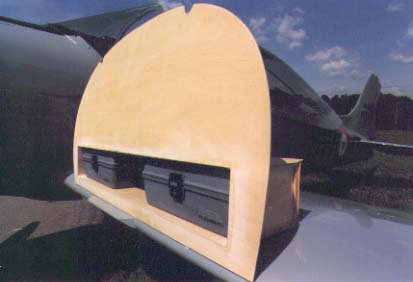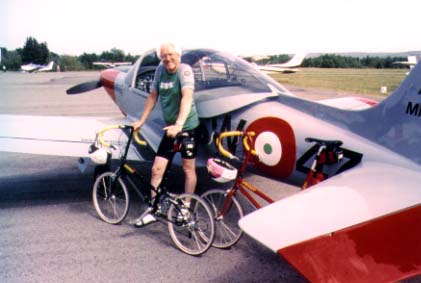The Flying Pidgeonhole
![]()
The Flying Pidgeonhole |
|
by Stephan Wilkinson
This appeared in the June 1993 issue of the Falco Builders Letter. |
Since we're both avid bicyclists, I have artfully rationalized to my wife the effort and expense of building the Falco as creating a device that will rapidly transport us to an enormous variety of biking spots, rather than our having to spend the next 30 years grinding around the same network of Hudson Highlands roads.
The next step was to find high-quality bicycles that would fit in the Falco. All of the folding bikes generally available up until now have been complete junk, made from gaspipe and fitted with department-store componentry. They're good for nothing more than carrying in your motorhome so you can look silly while you pedal around a KOA campground.
But just in time, an outfit called Green Gear, in Eugene, Oregon, came out with a truly splendid folding bike called the Bike Friday. It's about 98 percent as good as a conventional bike in the same price range ($900 to $1,200, depending on how you want to equip the Bike Friday); I'd characterize a Dahon-typically, the bike you see advertised in Trade-a-Plane and the Sporty's catalogue-as being about two percent as good.
So I gave a Bike Friday to Susan for Christmas, custom made to her measurements, figuring we'd try that one and get a second one for me if it proved to be as good as I thought it was. (I'd already test-ridden one, provided by neighbor/aviation journalist/Outside magazine writer David Noland, who was doing an article on the Bike Friday.)
The bike has proved to be terrific. It fits in a standard Samsonite suitcase and can be checked as luggage on airline flights-which we did with it-with no ticket agent the wiser that he should be charging us the exorbitant ($90 round trip now, I think) bike-as-baggage surcharge.
But it didn't quite fit in the Falco. It didn't come anywhere near fitting when encased in its suitcase, but I made a canvas bag for it, and that takes up a lot less room. Still, it needed about six inches more space, and that's the reason for the odd little baggage-bulkhead modification I made, as shown in the accompanying photo.

The modification consists of a pidgeonhole-like area slotted into a conventional bulkhead, sited to fit just below the rear fuel tank and to extend far enought aft that it doesn't interfere with the fuel line from that tank. Since our airplanes are typically nose-heavy, with constant-speed props and, in my case, a 180-hp engine, it creates no unusual weight-and-balance considerations.
It's an easy modification to make, and the construction should be intuitive simply from a glance at the photo. I used 1.5mm plywood for the box itself and the conventional 2mm plywood for the bulkhead. The first caution is that you should build the thing fairly strongly-use beefy triangular strips to fasten the box to the back of the bulkhead-because you don't want the box and whatever you're carrying within it to tear away if you hit severe turbulence.
The second caution is that you should never carry within it a load that you can't multiply times six, say, and not have the box fail. Below it are control cables, a fuel line and your static-system line, and you don't want to deal with flying into a thunderstorm plus having a mess of plywood and baggage fouling up your elevator cables. It makes a nice place to stuff a down parka or a light sleeping bag, but I'd be careful with anything much more substantial until you've screwed the thing to a supporting framework and loaded it with 100 pounds of bricks to proof-test it. I haven't done that yet, but I'm going to.
In fact, I'm also going to see if I can add some kind of permanent crossbrace under the box, across the inside of the fuselage, simply to help prevent catastrophic failure of the box from a turbulence overload. This won't be a consideration when I'm carrying the bicycles, since the pidgeonhole will be unloaded, just providing "airspace" for the bikes' front wheels, which extend slightly too far aft. But it also happens to be exactly the right size and shape to hold my traveling toolkit and my survival kit, which are in plastic toolboxes (as shown in the photo), and their combined weight is about 15 pounds.
What's in the survival kit? You'll have to read the September Builder Letter to discover that. But I'll give you a hint: among other things, it contains three condoms. (No, not in case I get lucky after I crash.)

Steve Wilkinson